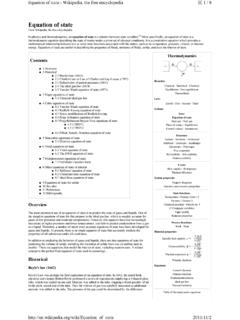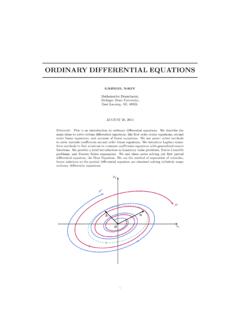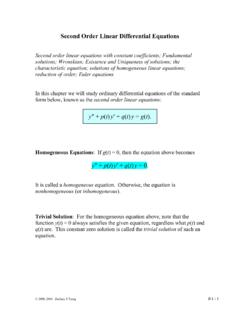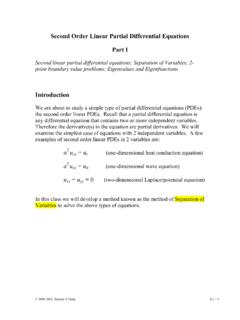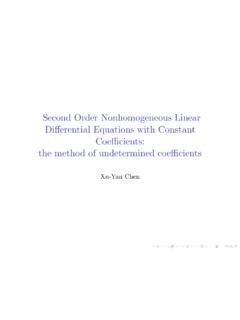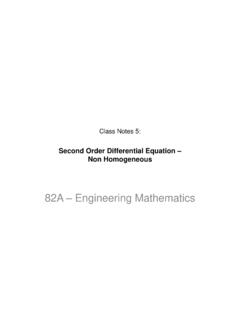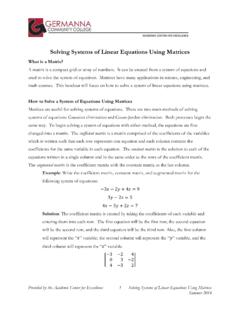Transcription of SECOND-ORDER LINEAR DIFFERENTIAL EQUATIONS
1 2nd- order ODE - 1 CHAPTER 2 SECOND-ORDER LINEAR DIFFERENTIAL EQUATIONS 1 Homogeneous LINEAR EQUATIONS of the second order LINEAR DIFFERENTIAL Equation of the second order y'' + p(x) y' + q(x) y = r(x) LINEAR where p(x), q(x): coefficients of the equation if r(x) = 0 homogeneous r(x) 0 nonhomogeneous p(x), q(x) are constants constant coefficients 2nd- order ODE - 2 [Example] (i) ( 1 x2 ) y'' 2 x y' + 6 y = 0 y'' 2 x 1 x2 y' + 6 1 x2 y = 0 homogeneousvariable coefficientslinear (ii) y'' + 4 y' + 3 y = ex nonhomogeneousconstant coefficientslinear (iii) y'' y + y' = 0 nonlinear (iv) y'' + (sin x) y' + y = 0 LINEAR ,homogeneous,variable coefficients 2nd- order ODE - 3 second order DIFFERENTIAL EQUATIONS Reducible to the First order Case I.
2 F(x, y', y'') = 0 y does not appear explicitly [Example] y'' = y' tanh x [Solution] Set y' = z and dzydx Thus, the DIFFERENTIAL equation becomes first order z' = z tanh x which can be solved by the method of separation of variables dz z = tanh x dx = sinh x cosh x dx or ln|z| = ln|cosh x| + c' z = c1 cosh x or y' = c1 cosh x Again, the above equation can be solved by separation of variables: dy = c1 cosh x dx y = c1 sinh x + c2 # 2nd- order ODE - 4 Case II: F(y, y', y'') = 0 x does not appear explicitly [Example] y'' + y'3 cos y = 0 [Solution] Again, set z = y' = dy/dx thus, y'' = dz dx = dz dy dy dx = dz dy y' = dz dy z Thus, the above equation becomes a first order DIFFERENTIAL equation of z (dependent variable) with respect to y (independent variable): dzdy z + z3 cos y = 0 which can be solved by separation of variables.
3 Dz z2 = cos y dy or 1 z = sin y + c1 or z = y' = dy/dx = 1 sin y + c1 which can be solved by separation of variables again (sin y + c1) dy = dx cos y + c1 y + c2 = x # 2nd- order ODE - 5 [Exercise] Solve y'' + ey(y')3 = 0 [Answer] ey - c1 y = x + c2 (Check with your answer!) [Exercise] Solve y y'' = (y')2 2nd- order ODE - 6 2 General Solutions Superposition Principle [Example] Show that (1) y = e 5x, (2) y = e2x and (3) y = c1 e 5x + c2 e2x are all solutions to the 2nd- order LINEAR equation y'' + 3 y' 10 y = 0 [Solution] (e 5x)'' + 3 (e 5x)' 10 e 5x = 25 e 5x 15 e 5x 10 e 5x = 0 (e2x)'' + 3 (e2x)' 10 e2x = 4 e2x + 6 e2x 10 e2x = 0 (c1 e 5x + c2 e2x)'' + 3 (c1 e 5x + c2 e2x)' 10 (c1 e 5x + c2 e2x) = c1 (25 e 5x 15 e 5x 10 e 5x) + c2 (4 e2x + 6 e2x 10 e2x) = 0 Thus, we have the following superposition principle.
4 2nd- order ODE - 7 [Theorem] Let y1 and y2 be two solutions of the homogeneous LINEAR DIFFERENTIAL equation y'' + p(x) y' + q(x) y = 0 then the LINEAR combination of y1 and y2, , y3 = c1 y1 + c2 y2 is also a solution of the DIFFERENTIAL equation, where c1 and c2 are arbitrary constants. [Proof] (c1 y1 + c2 y2)'' + p(x) (c1 y1 + c2 y2)' + q(x) (c1 y1 + c2 y2) = c1 y1'' + c2 y2'' + p(x) c1 y1' + p(x) c2 y2' + q(x) c1 y1 + q(x) c2 y2 = c1 (y1'' + p(x) y1' + q(x) y1) + c2 (y2'' + p(x) y2' + q(x) y2) = c1 (0) (since y1 is a solution) + c2 (0) (since y2 is a solution) = 0 Remarks: The above theorem applies only to the homogeneous LINEAR DIFFERENTIAL EQUATIONS 2nd- order ODE - 8 LINEAR Independence Two functions, y1(x) and y2(x), are linearly independent on an interval [x0, x1] whenever the relation c1 y1(x) + c2 y2(x) = 0 for all x in the interval implies that c1 = c2 = 0.
5 Otherwise, they are linearly dependent. There is an easier way to see if two functions y1 and y2 are linearly independent. If c1 y1(x) + c2 y2(x) = 0 (where c1 and c2 are not both zero), we may suppose that c1 0. Then y1(x) + c2 c1 y2(x) = 0 or y1(x) = c2 c1 y2(x) = C y2(x) Therefore: Two functions are linearly dependent on the interval if and only if one of the functions is a constant multiple of the other. 2nd- order ODE - 9 General Solution Consider the second order homogeneous LINEAR DIFFERENTIAL equa-tion: y'' + p(x) y' + q(x) y = 0 where p(x) and q(x) are continuous functions, then (1) Two linearly independent solutions of the equation can always be found. (2) Let y1(x) and y2(x) be any two solutions of the homogeneous equa-tion, then any LINEAR combination of them ( , c1 y1 + c2 y2) is also a solution.
6 (3) The general solution of the DIFFERENTIAL equation is given by the lin-ear combination y(x) = c1 y1(x) + c2 y2(x) where c1 and c2 are arbitrary constants, and y1(x) and y2(x) are two linearly independent solutions. (In other words, y1 and y2 form a basis of the solution on the interval I ) (4) A particular solution of the DIFFERENTIAL equation on I is obtained if we assign specific values to c1 and c2 in the general solution. 2nd- order ODE - 10 [Example] Verify that y1 = e 5x, and y2 = e2x are linearly independent solutions to the equation y'' + 3 y' 10 y = 0 [Solution] It has already been shown that y = e 5x and y = e2x are solutions to the DIFFERENTIAL equation. In addition y1 = e 5x = e 7x e2x = e 7x y2 and e 7x is not a constant, we see that e 5x and e2x are linearly independent and form the basis of the general solution.
7 The general solution is then y = c1 e 5x + c2 e2x 2nd- order ODE - 11 Initial Value Problems and Boundary Value Problems Initial Value Problems (IVP) DIFFERENTIAL Equation y'' + p(x) y' + q(x) y = 0 with Initial Conditions y(x0) = k0, y'(x0) = k1 Particular solutions with c1 and c2 evaluated from the ini-tial conditions. Boundary Value Problems (BVP) DIFFERENTIAL Equation y'' + p(x) y' + q(x) y = 0 with Boundary Conditions y(x0) = k0, y(x1) = k1 where x0 and x1 are boundary points. Particular solution with c1 and c2 evaluated from the boundary conditions. 2nd- order ODE - 12 Using One Solution to Find Another (Reduction of order ) If y1 is a nonzero solution of the equation y'' + p(x) y' + q(x) y = 0, we want to seek another solution y2 such that y1 and y2 are linearly independent.
8 Since y1 and y2 are linearly independent, the ratio y2 y1 = u(x) constant must be a non-constant function of x, and y2 = u y1 must satisfy the DIFFERENTIAL equation. Now (u y1)' = u' y1 + u y1' (u y1)'' = u y1'' + 2 u' y1' + u'' y1 Put the above EQUATIONS into the DIFFERENTIAL equation and collect terms, we have u'' y1 + u' (2 y1' + p y1) + u (y1'' + p y1' + q y1) = 0 Since y1 is a solution of the DIFFERENTIAL equation, y1'' + p y1' + q y1 = 0 u'' y1 + u' (2y1' + p y1) = 0 or u'' + u' 2 y1' y1 + p = 0 Note that the above equation is of the form F(u'', u', x) = 0 which can be solved by setting U = u' U' + 2 y1' y1 + p U = 0 2nd- order ODE - 13 which can be solved by separation of variables: U = c y12 e p(x) dx where c is an arbitrary constant.
9 Take simply (by setting c = 1 ) du/dx = U = 1 y12 e p(x) dx and perform another integration to obtain u, we have y2 = u y1 = y1(x) e p(x) dx y12(x) dx Note that e p(x) dx is never zero, , u is non-constant. Thus, y1 and y2 form a basis. 2nd- order ODE - 14 [Example] y1 = x is a solution to x2 y'' x y' + y = 0 ; x > 0 Find a second , linearly independent solution. [Solution] Method 1: Use y2 = u y1 Let y2 = u y1 = u x then y2' = u' x + u and y2'' = u'' x + 2 u' x2 y2'' x y2' + y2 = x3 u'' + 2 x2 u' x2 u' x u + x u = x3 u'' + x2 u' = 0 or x u'' + u' = 0 Set U = u', then U' = 1 x U dUdxUx U = e 1/x dx = e ln x = 1x Since U = u', u = U dx = 1/x dx = ln x Therefore, y2(x) = u y1 = x ln x (You should verify that y2 is indeed a solution.)
10 2nd- order ODE - 15 Method II: Use formula. To use the formula, we need to write the DIFFERENTIAL equation in the following standard form: y'' 1 x y' + 1 x2 y = 0 y2 = y1(x) e p(x) dx y12(x) dx 12dxxexdxx = x x x2 dx = x ln x 2nd- order ODE - 16 [Exercise 1] Given that y1 = x, find the second linearly inde-pendent solution to ( 1 x2 ) y'' 2 x y' + 2 y = 0 Hint: dx 1 - x2 = 1 2 ln ( 1 + x 1 - x ) [Exercise 2] Given that y1 = x, find the second linearly inde-pendent solution to y'' - y' x2 + y x3 = 0 [Exercise 3] Verify that y = tan x satisfies the equation y'' cos2x = 2y and obtain the general solution to the above DIFFERENTIAL equation.
